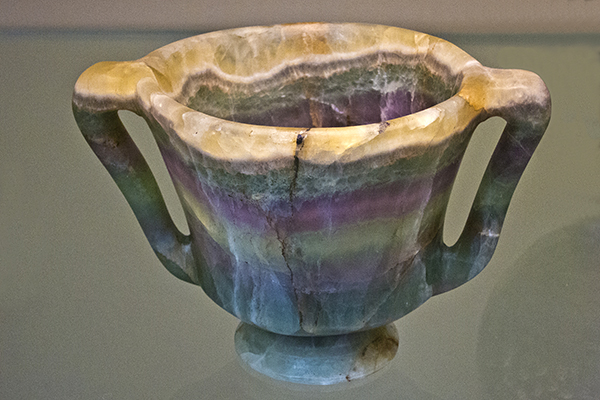

"If you drink your wine warm, a Myrrhine cup is best for hot Falernian; and the flavour of the wine is improved by it."
Martial, Epigrams (CXIII)
Pliny writes that it was the victory of Pompey over Mithridates that introduced myrrhina to Rome, bowls and cups of which he dedicated to Jupiter at his triumph (Natural History, XXXIII.18). In consequence, myrrhine ware immediately became desirable.
"Their value lies in their varied colours: the veins, as they revolve, repeatedly vary from purple to white or a mixture of the two, the purple becoming fiery or the milk-white becoming red as though the new colour were passing through the vein. Some people particularly appreciate the edges of a piece, where colours may be reflected such as we observe in the inner part of a rainbow" (XXXVII.22).
The owner of one such cup, for which seventy-thousand sesterces were paid, was so inordinately fond of it that he gnawed at the rim. Suetonius recounts of Augustus that, of all the royal spoils of Alexandria, he kept only a single agate cup (Life of Augustus, LXXI.1).
Pliny recounts disapprovingly that "It came to be deemed the proof of wealth, the true glory of luxury, to possess something that might be absolutely destroyed in a moment" (XXXIII.5). Perhaps the most famous example of the fragility of luxury is when Petronius, the author of the Satyricon and Arbiter Elegantiae (arbiter of elegance) in the court of Nero, was denounced to the emperor. Realizing his death was inevitable, he severed his veins and committed suicide in AD 66 (Tacitus, Annals, XVI.18-19). But, before he died, he broke a myrrhine ladle for which he had paid three-hundred thousand sesterces, rather than have it be used on Nero's own dining room table (Pliny, XXXVII.20).
"The enticement of the vices have augmented even art: it has pleased us to engrave scenes of license upon our goblets, and to drink through the midst of obscenities."
Pliny, Natural History (XXXIII.5)
Both cups are in the British Museum. The Warren Silver Cup, which was made about 15 BC to AD 15, is an example of a kantharos, a drinking cup with handles that now are missing.
Reference: Pliny: Natural History (1938-) translated by H. Rackham et al. (Loeb Classical Library).
![]()